How Jane Foster Became The Mighty Thor
Let’s dig into the story behind this Marvel classic with insight from those who created it.
Jason Aaron couldn’t help but highlight some of his recent acquisitions. The writer’s eyes darted around the room as we chatted on Zoom, recounting Target visits that invariably resulted in new items coming home.
A plastic Jane Foster Thor toy mask.
Mjolnirs of varying sizes.
Figures of the character.
“My guest room is basically a toy museum,” Aaron said.
It’s a tribute to a significant period in the writer’s career, both in time and importance. As you likely know, Aaron – alongside artist Russell Dauterman, colorist Matthew Wilson, letterer Joe Sabino, and an incredible collection of collaborators – crafted the story of Jane Foster as Thor, in which the God of Thunder’s once love interest became the Goddess of Thunder herself. Between 2014 and 2018, the character’s story was told over 38 issues, delivering a potent tale with the rarest of attributes for a Marvel comic: it had a beginning, middle, and end.
That story was part of a larger one by the writer and an even wider range of teammates, as Aaron spent eight years embedded in Asgard and the Ten Realms. 1 It’s one of the greatest runs in the history of both the character and publisher, something I’m sure director Taika Waititi would agree with.
Because as you also likely know, varying aspects of Aaron’s time in Asgard with partners like Dauterman and artist Esad Ribić will be getting their close up in Waititi’s Thor: Love and Thunder, the upcoming Marvel Studios film that stars the villainous Gorr the God Butcher and iconic shots straight from this period. Most crucially to us, though, Natalie Portman’s Jane Foster is the Goddess of Thunder in it, something few involved with the comics could have ever imagined.
But before Jane Foster could become Thor, that version could become a movie star, or the story’s architect could fill his home with toys, a fan favorite writer, an artist on his first significant run, and an array of others had to figure out what that character’s journey was. This is the story behind that story, exploring how Jane Foster became The Mighty Thor, the headwinds it faced, and how a modern Marvel classic was born in the process.
Former Marvel editor Lauren Sankovitch was an Asgardian veteran when Aaron signed up for Thor: God of Thunder, having worked with writer Matt Fraction during his run. And what stood out to her about the incoming writer from the start was his energy.
“I just remember he was very excited,” Sankovitch told me. “His big thing was, ‘I need this Thor to be someone that you really want to have a drink with.’”
Aaron was in a good spot to capitalize on that dream. He had a lot of cachet at Marvel in that moment, allowing him to tell the type of story he wanted to tell. As the writer noted, there’s a time when everyone feels like they’re “not supposed to be here” at Marvel, as if this connection could crumble at any moment. Coming off successful runs on titles like Wolverine and the X-Men and PunisherMAX, being named one of Marvel’s architects, 2 and co-writing a recent event in Avengers vs. X-Men, though, Aaron was entrenched at the publisher. Thor arrived “at the right time” for the writer.
This allowed him to “lay big plans” that would take him “a while to finish off.” He didn’t necessarily believe he’d be there for eight years, four ongoings, multiple minis, two events, and assorted one-shots, though. As both Sankovitch and Aaron emphasized, he isn’t Jonathan Hickman, someone the editor described as having it “all planned out” in “his notebook of amazingness.”
“But (Aaron) definitely came into the room with a grand plan of where he wanted to end up, with a couple other ideas on where things could go after that,” Sankovitch shared.
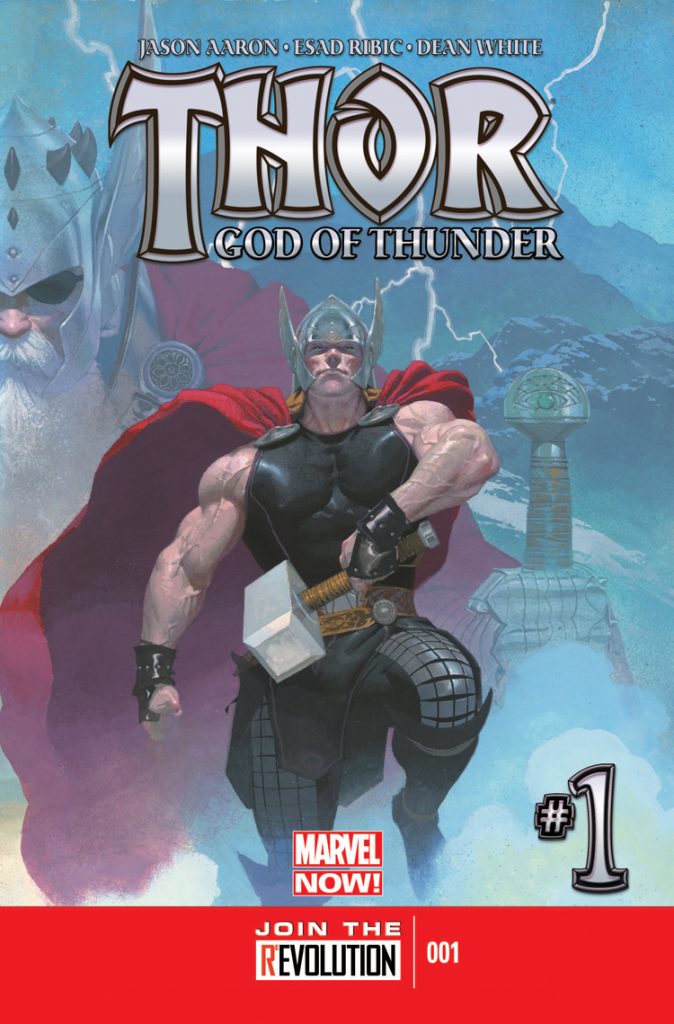
When Jane Foster as Thor entered the picture precisely is a little murky. Key figures in the process each had different ideas as to the exact timing of its emergence. What everyone could agree on, though, is that the roots of Foster’s turn as the Goddess of Thunder were there from the start.
Aaron walked me through his initial Thor document, including the entire God Butcher story, the Asgard/Shi’Ar War that arrived much later, 3 and assorted other story ideas, nearly all of which he managed to get to. The consistent theme throughout was a question of worthiness, the defining idea of the run, something that stemmed from the writer trying to confront the idea of gods as a person who didn’t believe in them.
“That to me was always the crux of, ‘How do I as an atheist write a book that’s about Marvel’s premier God?’” Aaron said. “And I very much wanted it to be about the premier God. It was my idea to call the book, Thor: God of Thunder, to do a God Butcher story, and to lean into the idea of a god and that worthiness idea. The fact that Thor would wake up every day not knowing if he’s going to be able to pick up the hammer, questioning his own worthiness…that was a fundamental part of it.”
That question of worthiness meant he always knew one crucial part of Jane’s story was on the horizon: “At some point I’m going to get to the story where (Thor) can’t pick (Mjolnir) up.”
That idea opened a lot of interesting storytelling doors for Aaron. While he wasn’t sure at the time what might trigger Thor’s crisis of worthiness, it inspired fascinating questions. What are the ramifications of that? What does that mean for him? And, most importantly: if Thor can’t pick up Mjolnir…then who can?
There were two major differences in Aaron’s initial framework for this story, though. One was that he initially viewed it as “an arc” rather than the half decade status quo it became. That quickly shifted. Both Sankovitch and Wil Moss, the editor that followed her on the Thor titles, shared there was significant internal confidence at Marvel about Aaron’s run and the idea of a new Thor, enough for everyone to aim higher with this story.
The other difference was who it might be. When I asked whether this new Thor was always meant to be Jane Foster — expecting Rosalind “Roz” Solomon, the wondrous S.H.I.E.L.D. agent introduced in Thor: God of Thunder #12, to be the original choice if there was one — Aaron told me that was not initially the case. But Solomon wasn’t the first pick. Thor’s mother, Freyja, was who Aaron imagined picking up the hammer.
That too changed quickly, and it was the same issue that Solomon first appeared in that began the shift. Thor: God of Thunder #12 was one of the finest issues from Aaron’s larger run, as the writer and current Thor artist Nic Klein teamed to give insight into what a day in the God of Thunder’s life is like when he’s on Earth and not doing Avenger things. It was also when Jane Foster and her battle with breast cancer were introduced to the run. At the time, Aaron said her arrival was just about what was right for the story at the time. But it planted an important seed.
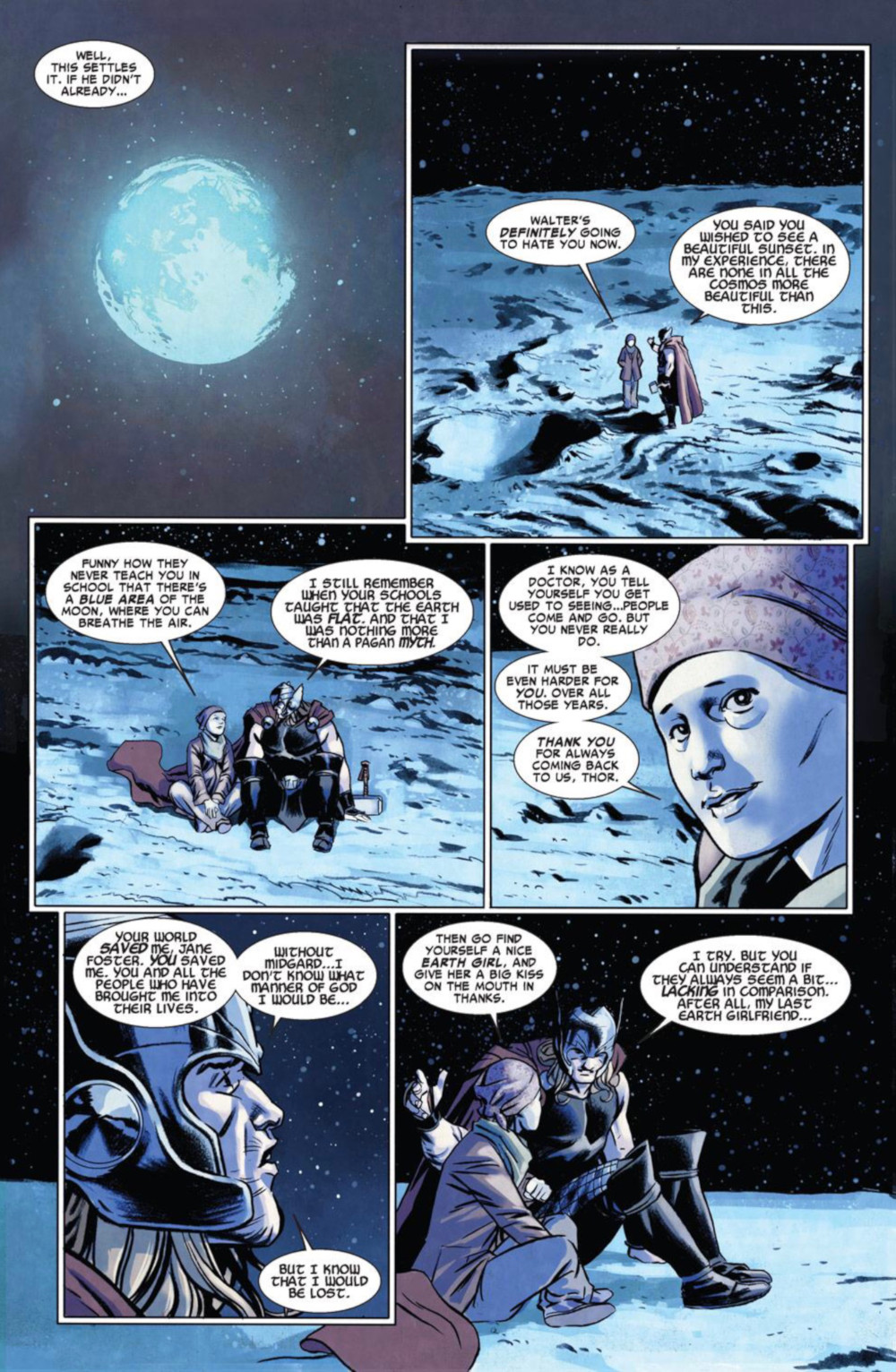
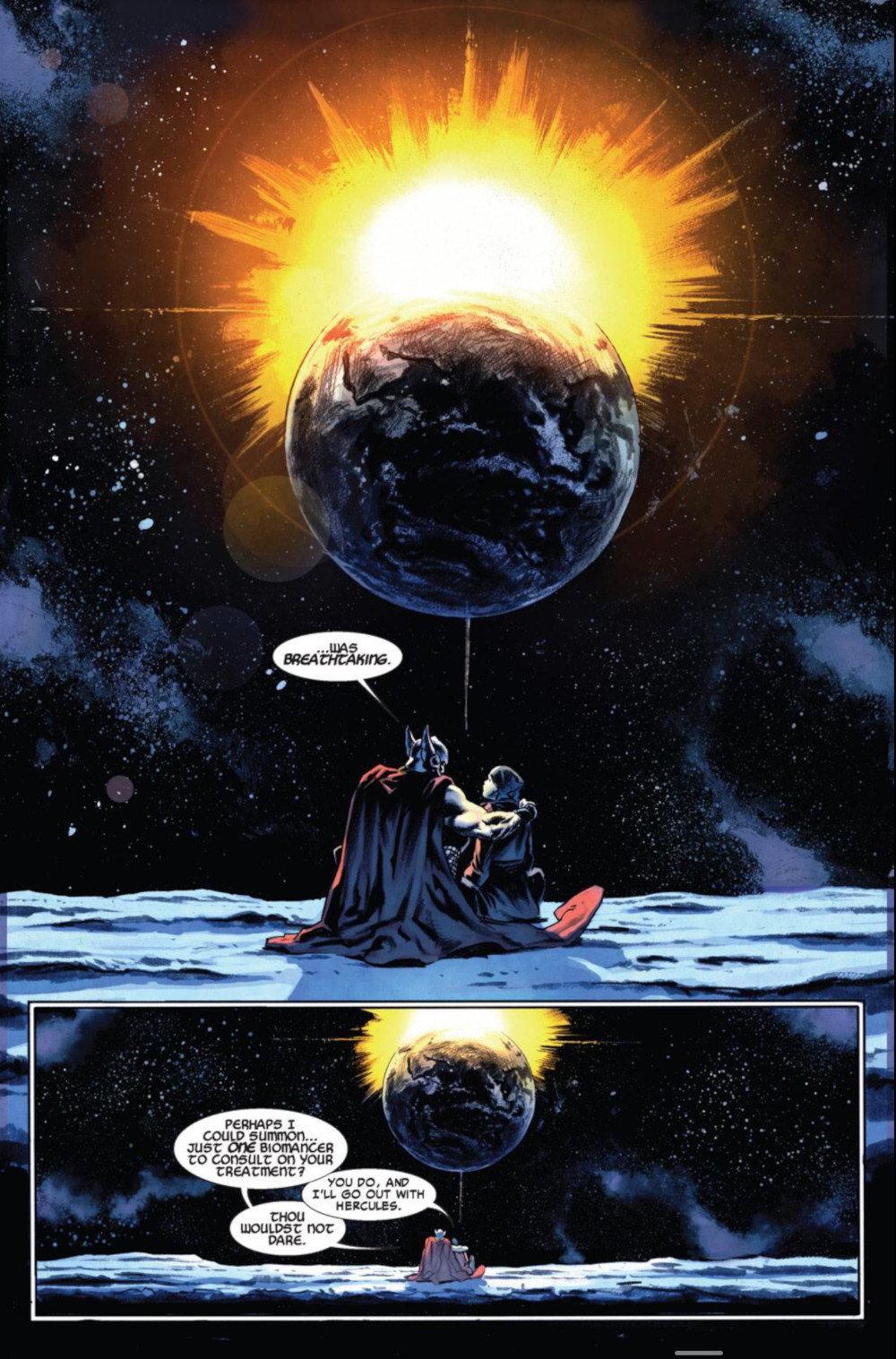
“When I had Jane pop up in, the idea was really to show she’s still a part of his supporting cast, that they’re not a romantic item anymore, and she’s dealing with breast cancer,” Aaron said. “(I wanted to) see how Thor responds to that, and what her perspective is after having the dealings she’s had with his corner of the world.”
Aaron knew Marvel was invested in the idea of someone else picking up the hammer. As he was tackling that issue, though, he realized that Jane as “part of that equation (was) exciting.”
“I set myself up for that without knowing what I was setting myself up for,” Aaron said. “And it was just one of those things that grew.”
Aaron quickly realized that Jane as Thor had all the markings of a classic Marvel tale in a very specific sense. While he was excited for it and even asked for the job, Aaron was not a “huge Thor fan” coming into Thor: God of Thunder, sharing that he had “never read that many Thor comics” outside of “a lot of the (Walt) Simonson stuff as a kid.” That meant he had homework. He endeavored to read Thor’s story from the beginning after he got the job. Aaron described Stan Lee, Larry Lieber, and Jack Kirby’s work with the character as “some of my favorite Kirby ever.” The foundation of the Jane Foster as Thor story came from reading that trio’s run, particularly when it came to Donald Blake, Thor’s original alter ego.
“That original idea of Donald Blake…that first appearance sets up that the inscription on the hammer, 4 this promise of a transformation of power,” Aaron shared. “And Blake is this guy walking with a cane who becomes a superhero who flies around and saves people. When he’s away from the hammer for too long, he changes back, and he’s got his secret identity. That’s a classic Marvel Comics set up.
“I think the biggest, truest version I’ve ever done of that is this Jane Foster story.”
This story also came at the perfect time for the publisher. It was a period of change at Marvel, one of regular relaunches back to number one for assorted ongoings. With another on the horizon – Avengers NOW! for those keeping track at home – then Marvel Editor-in-Chief Axel Alonso pitched Aaron on launching this Thor in a new title.
“Once it was clear, ‘This is not just going to be an arc, this should be a new book,’” Aaron said.
“Then I knew this was Jane’s story.”
As the story solidified and Jane became internally known as the soon-to-be Goddess of Thunder, there were a few dominoes that needed to fall before this new Thor title could launch. One was Thor had to become unworthy of the hammer. This played out in Aaron and Mike Deodato’s event series Original Sin, in which Nick Fury breaks Thor with three simple words. 5 Another was this new version of Thor had to be designed.
Now, here’s where a misconception might be resolved. I believed – and others I spoke to thought this as well – that it was eventual Thor artist Russell Dauterman who designed Jane. Not true! It was actually Thor: God of Thunder artist Esad Ribić. The character first appeared in the pages of Thor: God of Thunder #25. To draw the issue, Ribić had to first design her.
Moss still remembers when he first saw the design. It was during a Marvel retreat, a “fun,” “hectic” time for editorial staff. They get to brainstorm the future of the publisher offsite, but they also miss “a day’s worth of work.” During a break, the editor scurried away to catch up on email.
“I took my laptop to Starbucks, got on Wi-Fi, checked my email, and I remember Esad’s design for Jane was in there,” Moss said. “It was one of those great moments.”
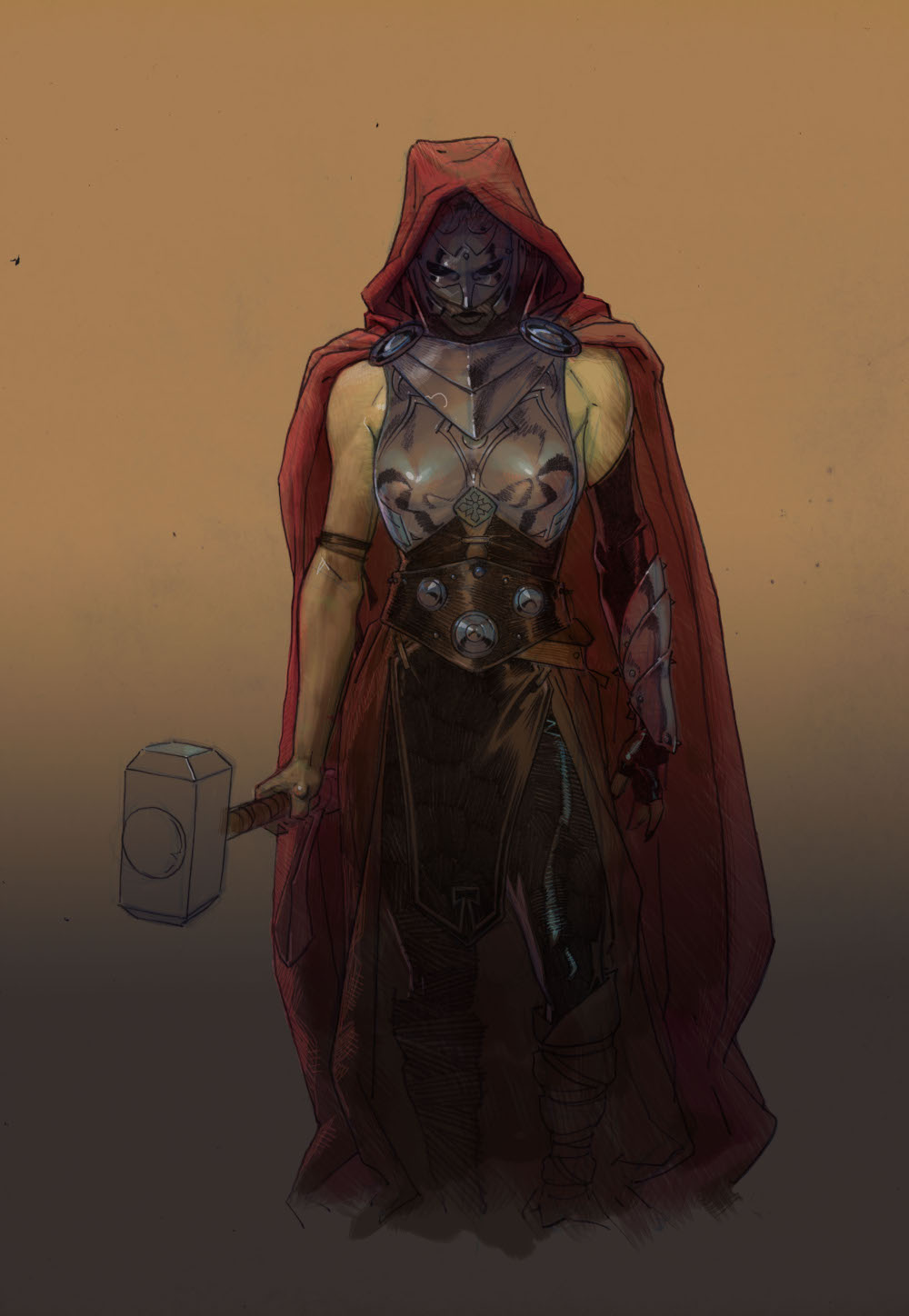
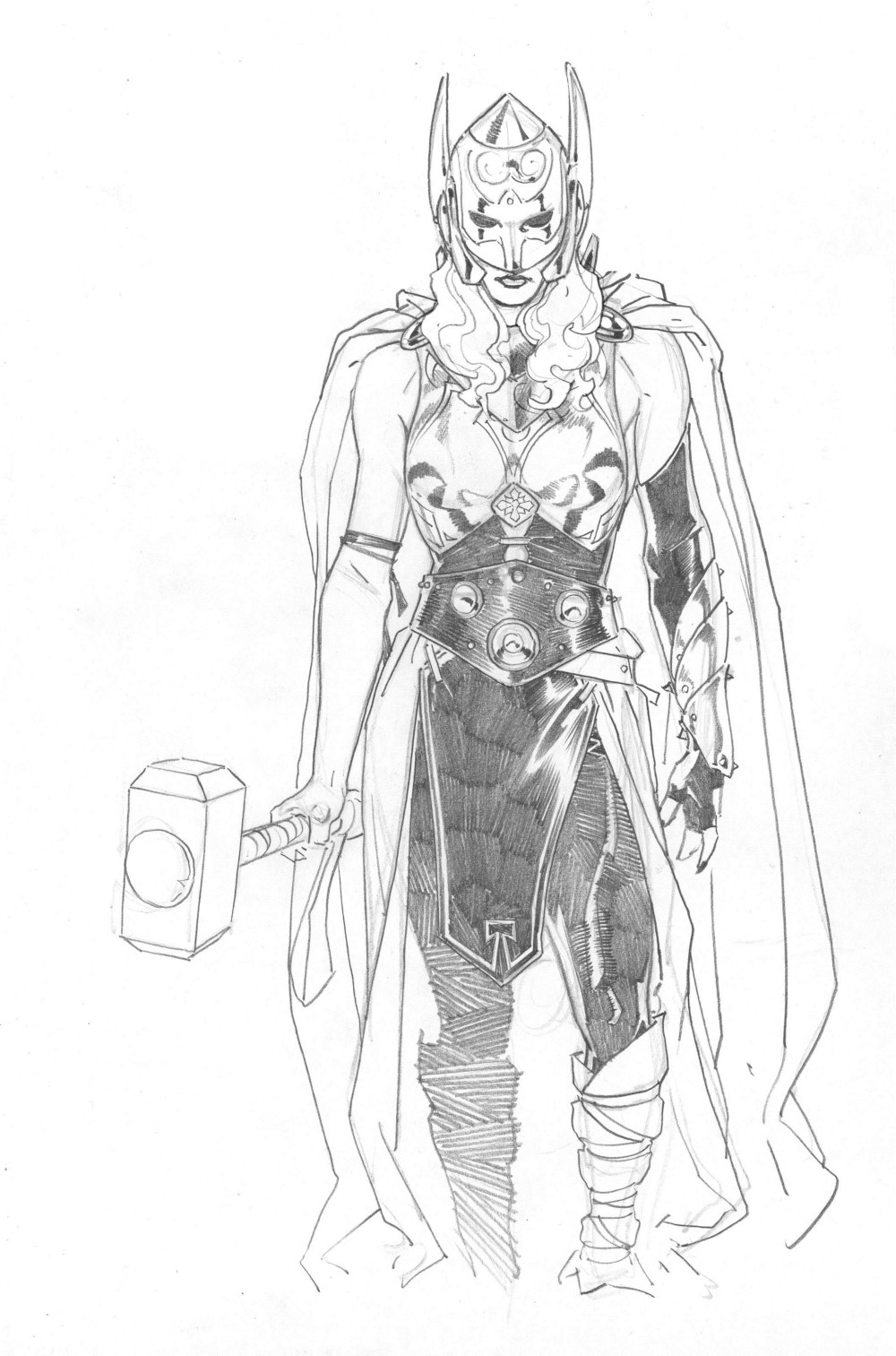

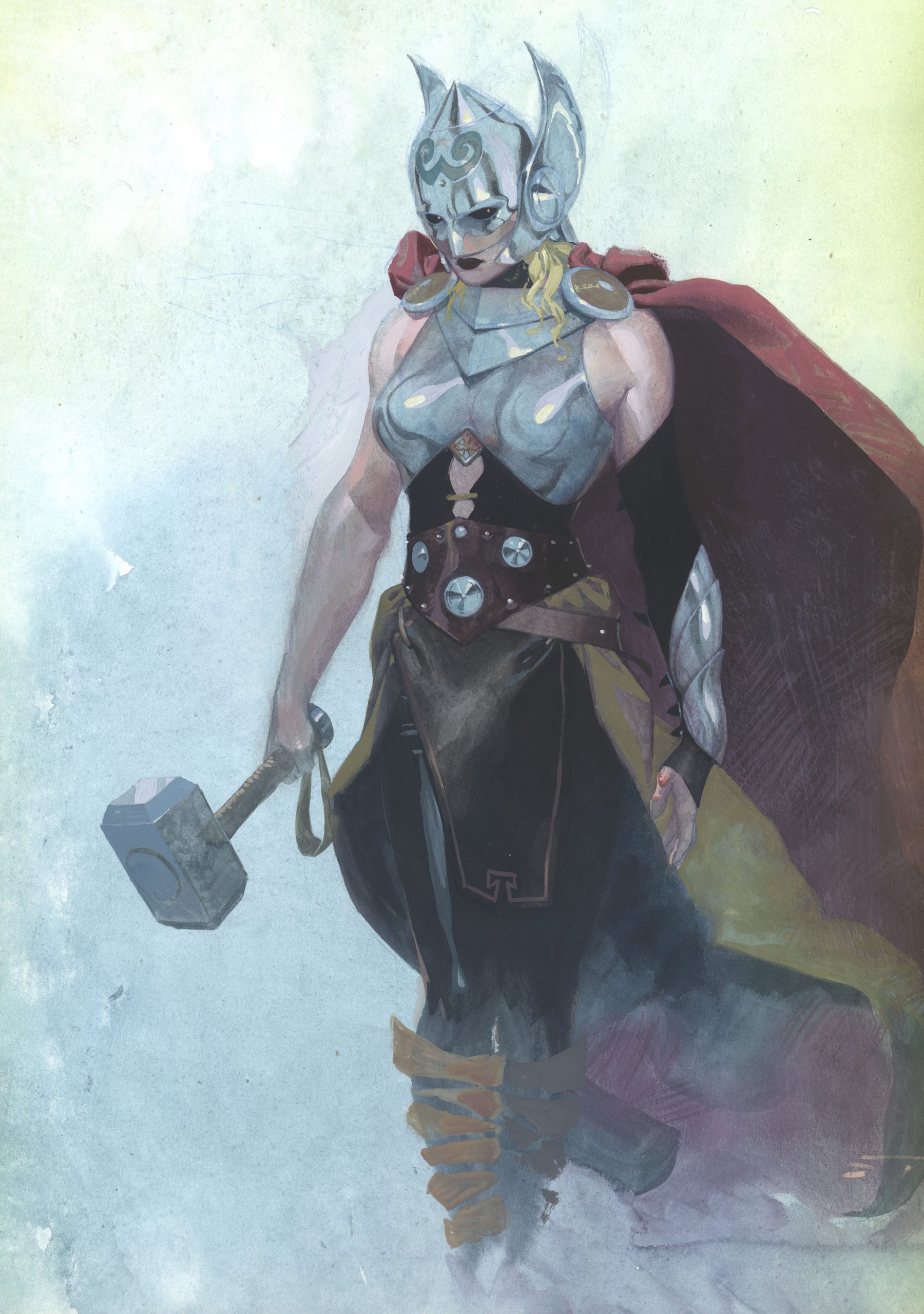
It’s easy to understand why. It was an instant classic. Dauterman’s now considered one of the strongest superhero costume designers, and he only had glowing things to say about Ribić’s look for the character.
“I love how the design feels like Thor without being a copy of the Thor Odinson costume. The large belt with circle details, the skirts, the symbol on the helmet — I really love those elements, especially,” Dauterman told me. “They feel like Marvel’s Asgard, while also feeling fresh and new.”
Aaron clearly agrees. As we discussed Ribić’s design, he turned his camera to share something in his office: Ribić’s original design hanging on his wall. It was a great look, but there was still one last thing to do. They had to find an artist to bring this character and title to life.
While you likely know him now as one of the finest artists in comics, as this story was coming together, Russell Dauterman wouldn’t have likely been the consensus favorite to do that. A relative unknown at that time, his most prominent projects were a BOOM! Studios superhero series 6 and a brief run on a Cyclops solo series at Marvel. Sometimes, though, it’s less important to be widely known than well-liked by the right people. In Dauterman’s case, he had a supporter on Team Thor.
“I was a fan of Russell’s ever since I’d seen an X-Men print (of his) at New York Comic Con,” Moss told me. “I was at DC then, but when we were casting around for Thor artists, I just started championing for Russell.”
Ribić was a tough act to follow. Dauterman said he was “absolutely intimidated” to follow Ribić’s “Frazetta-esque” work, expecting that his own style wouldn’t be as “well-received,” even as he accepted the job. That hard stylistic shift was part of the appeal to Moss, though.
“I was advocating for a big tonal shift. If you’re going to change, let’s really change,” Moss told me. “And I knew that this would be a story that felt more human and down to earth than God of Thunder. It was luck that Russell was available and that I was able to sell everybody else on him because he didn’t have much under his belt then.
“I just knew in my gut that he’d be a good fit.”
It was a life-changing time for the artist, as he was offered the job right before he got married. He accepted, and as he told me, “When I got back from the honeymoon, I was drawing Thor!”
The appeal to Dauterman was multi-faceted, but the biggest selling point was the story itself. Moss sent the artist Aaron’s outline, and within it, he found “the plan for the first arc, descriptions of the characters, and what became the end of the series in The Death of the Mighty Thor arc.” While details changed, the beginning and ending were “all in the outline.” How long it would go was uncertain — Dauterman said he “knew the series was intended to be ongoing,” but its success would determine “how many arcs” there might be before the ending — but he knew he connected with the concept.
“I thought the whole idea — Jane’s arc — was wonderful,” Dauterman said.
“I thought it felt special.”
It was clear from the start that it was special, just as Dauterman believed. The team — including Dauterman’s now well-established partner in colorist Matthew Wilson and letterer Joe Sabino — hit the ground running with Thor #1, an excellent first issue that introduced this new Thor on its final page without revealing who it was. This first volume for the character was a curiosity for two main reasons: one, that mystery at its core; and two, it was an unusually quick, eight-issue jaunt before relaunching.
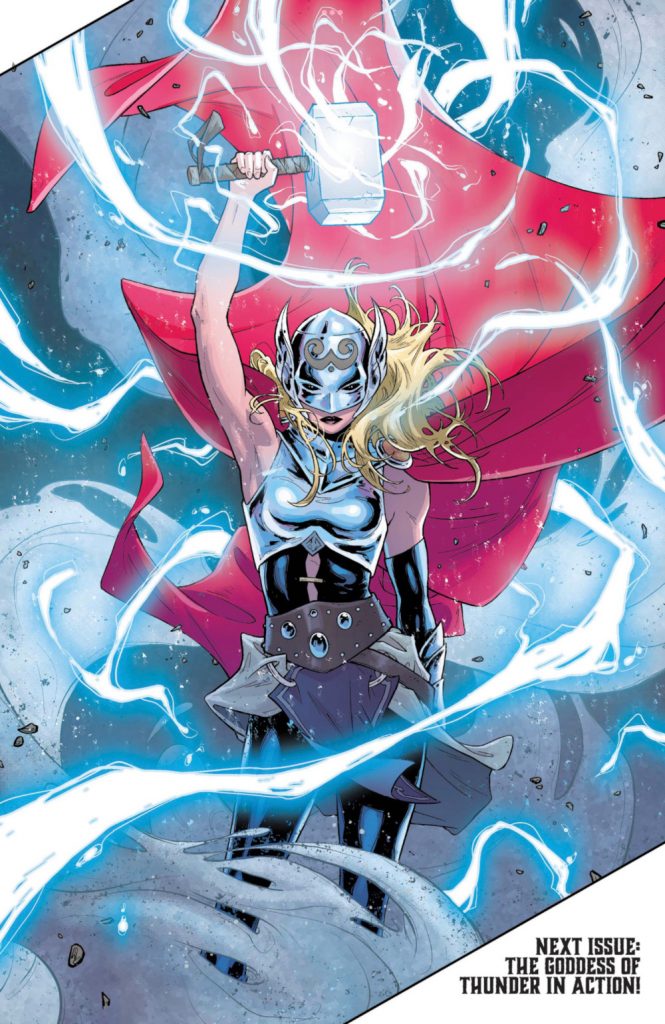
The latter was a publishing necessity, and the former came from that to a degree. Each was connected to the pending arrival of Jonathan Hickman and Ribić’s monster, line-wide event Secret Wars. It brought a hard stop to the entire Marvel line, as every title ended and was replaced because of that event. 7 This new ongoing was effectively a long mini-series. The team just leaned into that restriction by focusing on one question: “Who is this new Thor?”
“I knew I had eight issues until we got to (Secret Wars),” Aaron said. “That was a good period to play with the mystery and reveal it right at the end, knowing all along that it was Jane.”
It was always a balancing act. They knew they wanted a big hook in this first volume. But they also realized that a mystery “can overstay its welcome,” as Moss shared. Eight issues proved to be the perfect length. That Secret Wars limit didn’t restrict that part of the tale, instead giving it a rare focus. Readers were just like Odinson – which is what Thor starts calling himself – as the long-time Avenger had a scroll’s worth of potential secret identities for this new Thor that he investigates throughout the volume. Everyone had an idea as to who it was!
Aaron loved that, even if the team was eager to get to the meat of the story. As the writer told me, “It’s rare I get to write a secret identity.” And the mystery worked! Most of the betting action lied on Solomon being Thor, even if some believed she was a red herring. But the writer was concerned that a scene in issue #6 of that volume – in which Odinson meets with Jane to determine if it could be her, before scratching her name from the list because of how ill she was – was such an obvious misdirection that it would have an adverse effect on the mystery.
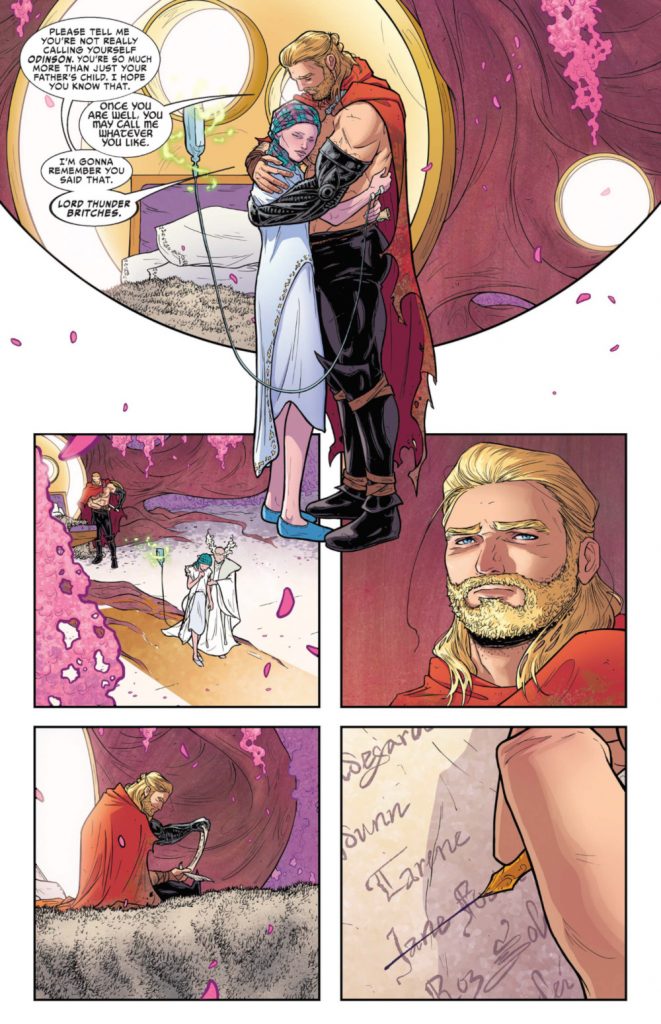
“I thought as soon as I did that, people would go, ‘Oh, it’s definitely her,” Aaron said. “But most people still were looking at Roz or Thor’s mom.” 8
The real answer, of course, was Jane, and it was important to the team that this version of the character wasn’t a derivative of Odinson but truly the mighty Thor herself.
“I wanted her to clearly be Thor,” Aaron said. “She has the hammer; she’s commanding the lightning and the thunder. She’s the Goddess of Thunder. She’s the center of this corner of the Marvel Universe.
“She is Thor.”
They still wanted to distinguish the character from Odinson, though. There were several ways they did that early on. Ribić’s original design helped. Jane had her own approach to battle and engagement with allies. Aaron even wrote the character differently from a formalist standpoint, leaning into thought bubbles to pair and contrast Jane’s human thoughts with her Asgardian dialogue. That last element was something the writer was an enormous fan of, even if it made him a bit trepidatious.
“I don’t think Jason ever really gets nervous. He tells the story like a storyteller. But I remember he was a little concerned about how the thought bubbles would go over just because it hadn’t been used in a while,” Moss said. “They ended up working out great.”
Just as Aaron’s stylistic choices differentiated this version of Thor, Dauterman’s did as well. While the artist endeavors to make each character he draws distinct, Jane as Thor was especially emphasized to distinguish her from Odinson.
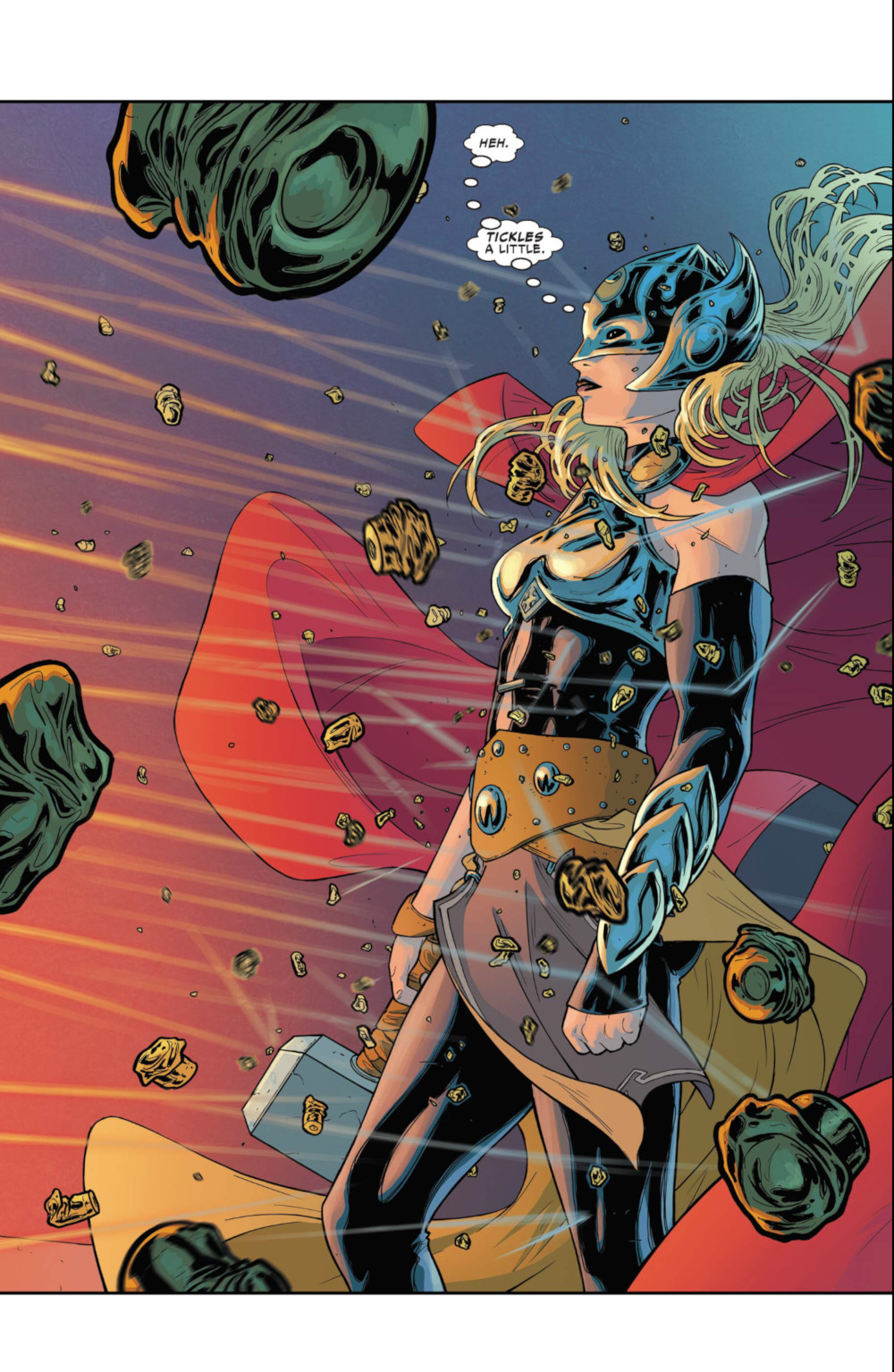
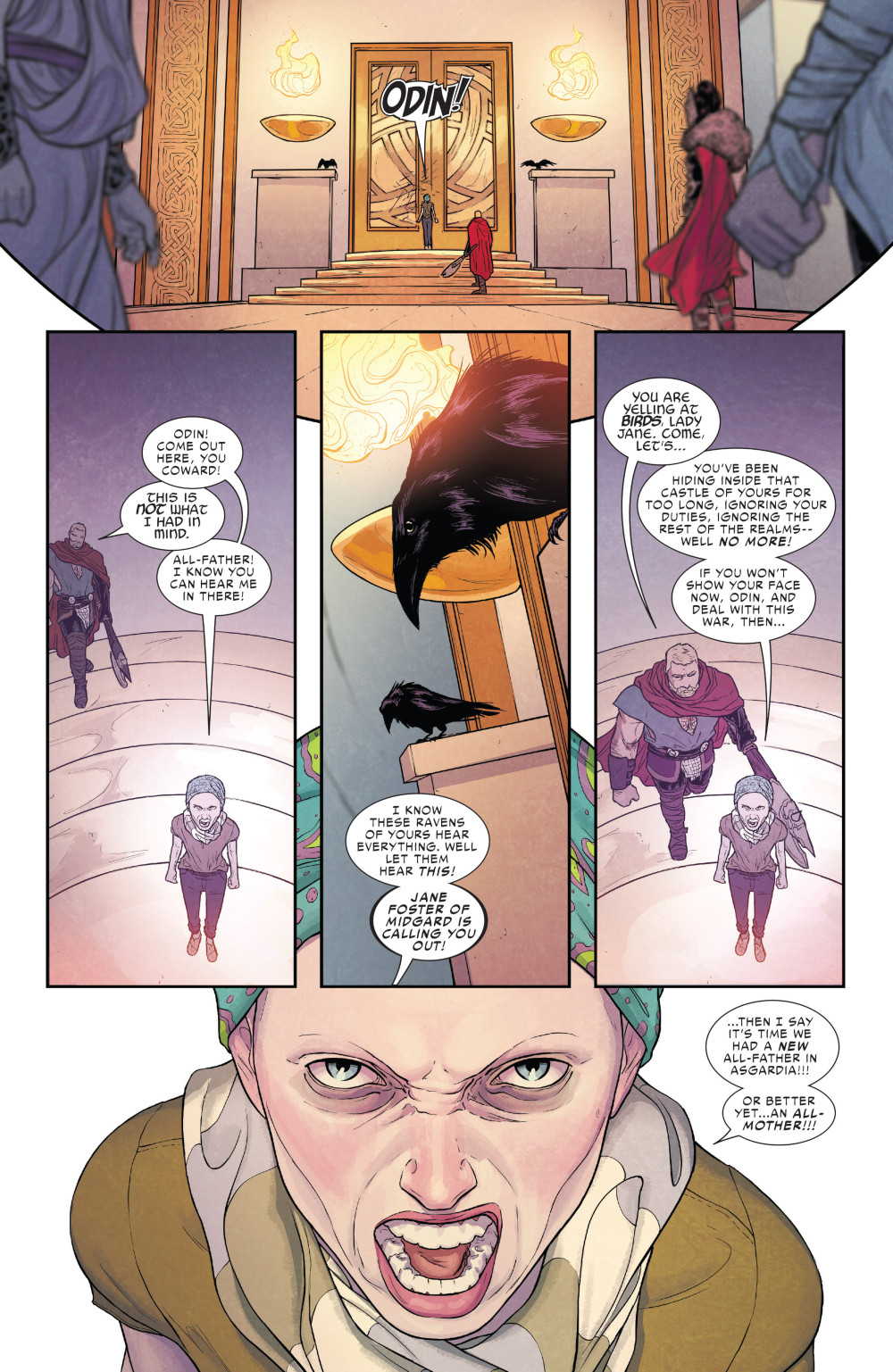
“I tried to blend traditionally feminine and masculine characteristics — things like big arm muscles, and long, flowing hair, widespread poses and delicately draped fabric,” Dauterman said. “And I tried to convey confidence and power with her posture and take-no-shit attitude with her facial expressions, usually a snarl or battle cry.”
Dauterman didn’t want to just bring strength and contrast to Thor, but to Jane in her human form as well, even as she suffers from an illness that was sapping the life from her.
“I wanted to show contradictions in their physical appearances, the way they stood, their body types, to play up the dichotomy in the two, and to emphasize how sick Jane was and how being Thor was making that worse,” Dauterman told me. “Another thing I wanted to do was to show the strength of Jane-Thor reflected in Jane’s face, showing that the strength and courage of Thor was always in her, even if she was physically weak from cancer. I tried to convey that through her eyes and facial expressions.”
My favorite point of differentiation, though, both in these eight issues and in the 30 issues of The Mighty Thor 9 that followed, was Jane’s relationship with Mjolnir. Where Odinson uses it as a hammer looking for a nail, Jane engaged with Mjolnir almost as a collaborator, albeit one that was occasionally a bit wild for her taste. 10 One of Dauterman’s favorite pages shows that relationship nicely. It’s in The Mighty Thor #11, and it finds Thor and Mjolnir staring at each other in space after the hammer does things no one ever knew to be possible. 11 The artist believes that moment effectively depicted the understanding between the two.
“I like that because it shows the hammer with more autonomy, and not as an inanimate object,” Dauterman said. “And it hopefully shows Jane thinking of the hammer as something more also.”
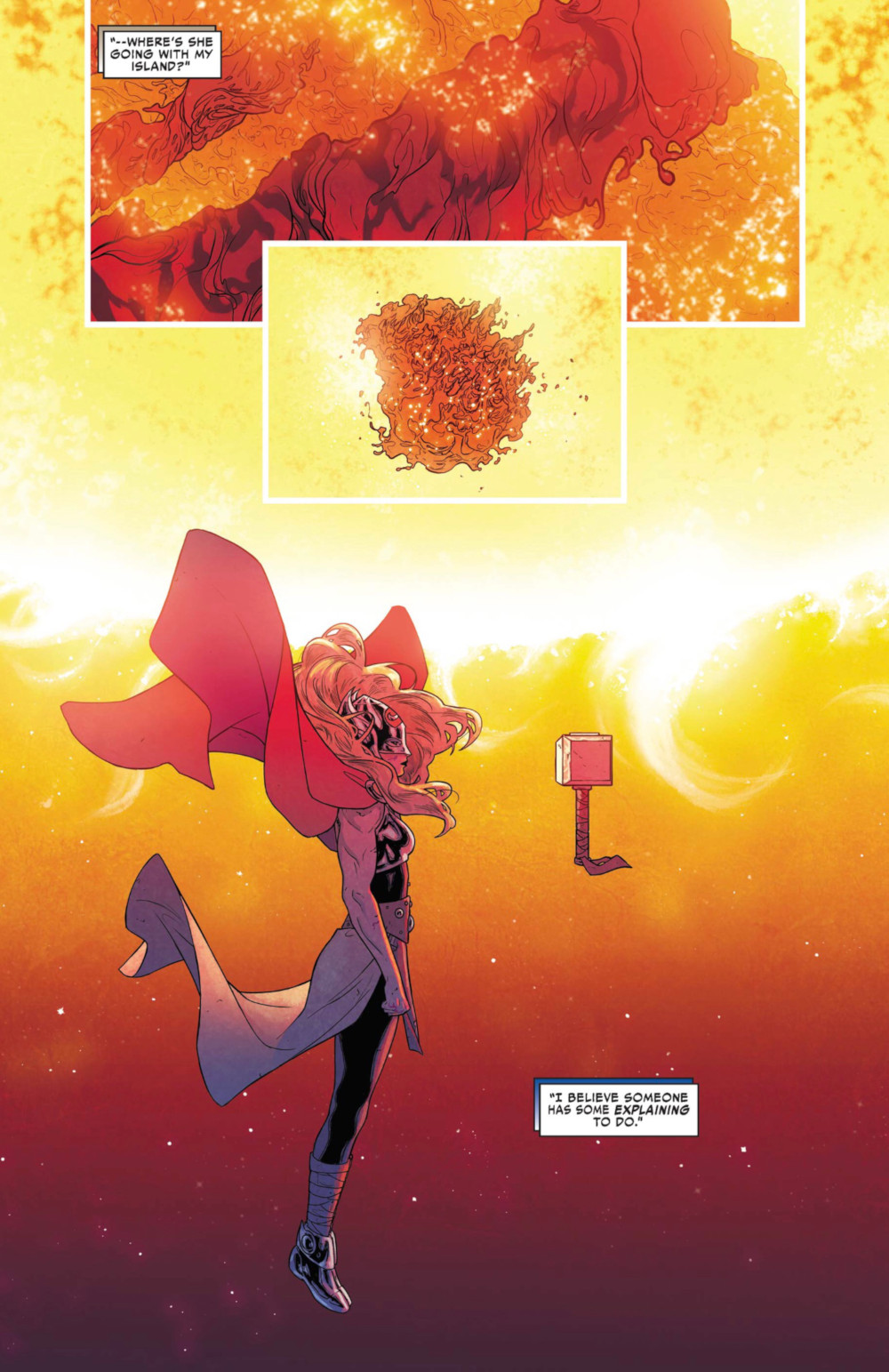
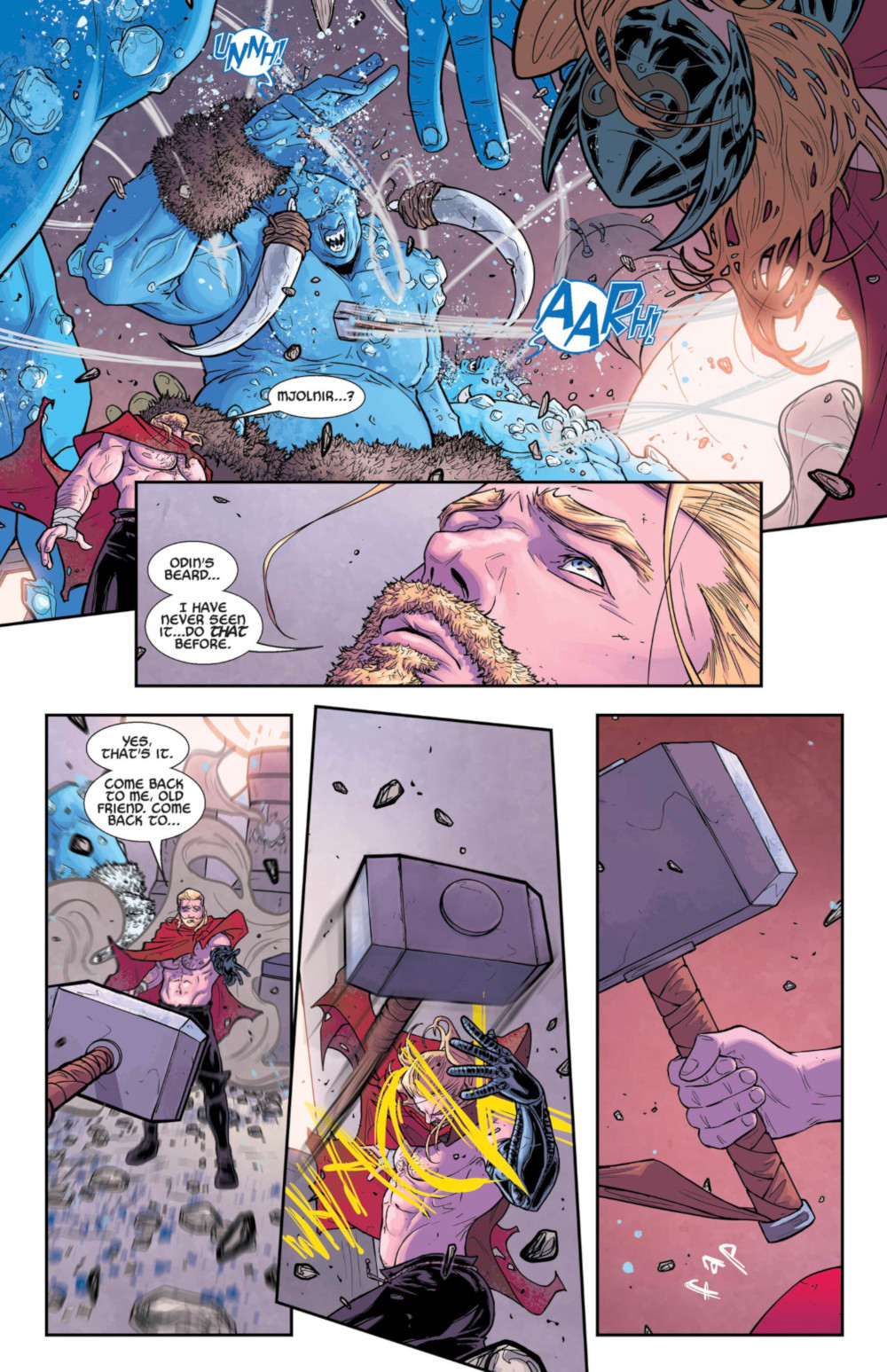
The team wanted to make Mjolnir more of a character, so they had it engage with Jane differently. The way it flew after being thrown and its overall capabilities were different than previously shown. This made an impact on two fronts. It underlined that Jane had a special relationship with Mjolnir, and it also troubled Odinson to see how it behaved with her. Aaron compared it to seeing an ex with someone else and knowing they were better off without you, feelings the team showed in Odinson throughout.
The inscription on the hammer even changed because of Jane. That was something Aaron wanted to do since he realized it had been the same since Thor’s first appearance. It was important to not just have that inscription change – from “if he be worthy” to “if she be worthy” – in the very first issue of this run, but to have it shown on panel. It was a mission statement, a crucial beat that emphasized how things would be different going forward.
This eight-issue opening salvo was advantageous for the creative team, as it allowed them to have fun with the mystery of “Who is Thor?” while getting to define the character and how she differed from Odinson. But it also was useful in that it was a testing ground for the idea’s viability, allowing Marvel time to see if readers would respond to it.
Aaron told me that if orders weren’t there, the run could have scrunched down to a single volume, with Odinson returning when Secret Wars wrapped. It was unlikely. But it was a possibility. The good news for everyone is it wasn’t necessary, because the response was massive — for better or worse.
It quickly became clear that this project “was going to be a different kind of beast,” as Aaron put it. The new volume and version of the character were announced on the daytime TV series The View, with series co-host Whoopi Goldberg’s walkthrough of the announcement inspiring broad coverage in a way comics rarely get. The feedback was immediate and massive. Moss and Aaron both described the “media frenzy” as something unlike anything they had experienced before.
Naturally, it was rather polarizing. There was a vocal subset of people who were extremely mad. A common belief – including amongst headline writers, apparently – was that Thor’s gender was changing. Moss emphasized that much of the anger came from people who “weren’t really even paying attention.”
The more things change, the more they stay the same, apparently. Aaron noted that anger is returning as Thor: Love and Thunder’s release approaches, with the same lines of pushback recurring. It’s Groundhog Day, but with angry fanboys who don’t understand the story instead of Stephen Tobolowsky. 12
“It’s almost like being caught in a time loop where every time there’s a new thing – when we first announced the story, when the story came out, when they announced we’re going to do a movie of this story, when the trailer came – there’s people who say basically the same shit like they’re the first person to ever point out like, ‘Wait a minute. His name is Thor. She can’t be Thor,’” Aaron said.
The writer didn’t want to push back in public, though. He preferred to let the comic do the talking.
“Odin’s the one who says, ‘I named you Thor. You can’t give your name away.’ That’s a valid thing to have that character raise in the story,” Aaron said. “But let the story address that.

The team wasn’t worried about the complaints, though. If you read through the first issue of the run today, you’ll find Aaron roasting a malcontent who wrote a letter in. More than that, negativity can be a positive in its own way. As Aaron told me, “Sometimes you can tell (how big something is) just by the amount of the people who are pissed off about a story that doesn’t even exist yet.”
They knew they were on the right path. While the detractors were loud, the positive side dwarfed the negative one both in sentiment and numbers. 13 It “drowned out all the other noise,” according to Aaron.
Oh, and Thor #1 was a hit, debuting as the third highest ordered comic of the month, with its orders surpassing what Thor: God of Thunder #1 received. More than that, it genuinely moved people. Aaron shared that he’s never made a Marvel comic, before or after, that more deeply affected readers.
“This is the only time I’ve done signings where people come up and start crying, and I start crying, and everybody’s crying,” Aaron said.
“People weren’t doing that when I was writing Wolverine.”
So why exactly was Jane’s time as Thor such a success? Moss noted it offered an easy jumping on point for readers, as Jane gave “fresh eyes” to Asgard and its residents. Dauterman cited how they were able to deliver a “beginning, middle, and end by the same creative team,” a truly rare trait. Polygon’s Entertainment Editor Susana Polo emphasized the character’s iconic look, and how it quickly inspired cosplay and fan art.
Those are all important. But there are a few core reasons that stand out above the rest, with one being the most obvious differentiator: this Thor was a woman. It was a hook at the beginning for Marvel, and also the run itself. Much of that came down to representation. Moss said they regularly heard from readers who loved seeing one of Marvel’s biggest characters “look like them.”
That connection was likely elevated by the relative dearth of women heroes in superhero media at the time. Up until then, there was a “scarcity of characters like this,” as Polo put it. While the ecosystem has changed to a degree, with women-led movies and TV shows like Black Widow, Birds of Prey, Supergirl, and more arriving in recent years, Polo noted “it’s easy to forget how absent characters like that were from wide audience projects, even as late as 2015.”
“(Jane) came around at a time where that was still a big deal, and Marvel was certainly leaning into the big deal of that in the 20-teens,” Polo shared. “The scarcity of it was part of how she became known to the broader public.”
There was a path to that not working, of course. If the story itself was ineffective, it would have gone nowhere. That’s why one of the other keys was its quality. Over its nearly 40 issue run, Jane’s story was expertly told by Aaron, Dauterman, Wilson, Sabino, and others. It was one of the strongest stretches in Thor’s history. Polo mentioned that as a driver of the character’s impact. As she said, “It was not just a concept and then poor execution.”
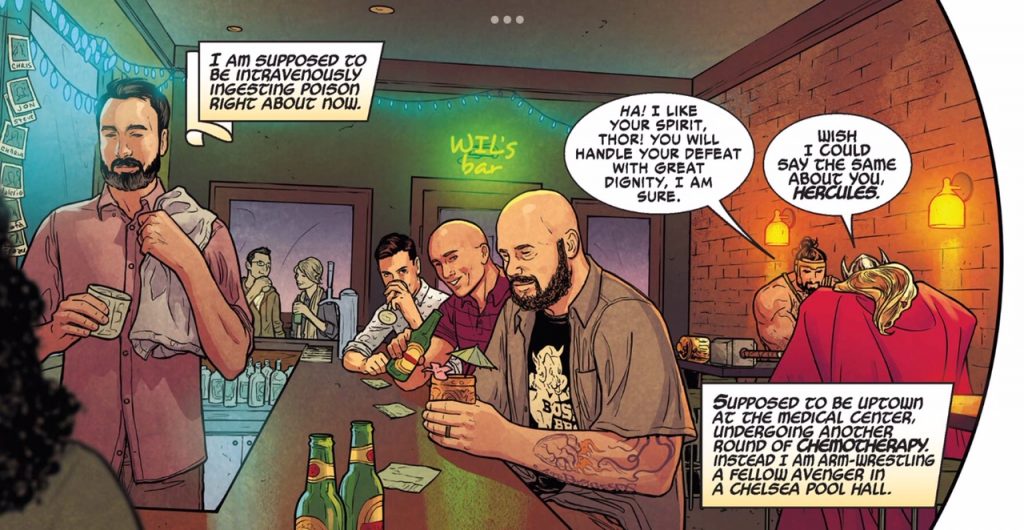
It helped that the team was loaded from top to bottom, with Aaron, Dauterman, Wilson, Sabino, and the editorial team each at the top of their game, a unit as simpatico as you could find. Despite how tight the team seemed to be, Dauterman shared that he only met Aaron in person after their run on The Mighty Thor ended, with only one phone conversation preceding that. Most communication played out via email with the title’s editors. They just fit each other naturally in a rare way.
Speaking of fitting, the whole endeavor being such a tidy partner to Aaron’s larger run was important as well. Even if you were skeptical of this new Thor, it was easy to see that Jane’s tale meshed perfectly with the larger ideas of unworthiness at the core of the story. As Polo told me, “Anybody who got mad about her being Thor, it’s like, ‘Well, read the book, man.’”
“The whole thing is about mortals and gods and how the mortal experience is what unlocks being worthy,” Polo added. “Having a feeling of mortality and knowing your end is vital to that.”
The humanity of the character might have been the most critical aspect to the run resonating as much as it did, though. Jane being a mortal standing in for a god — and one that was suffering from a disease that almost everyone on the planet has a connection to — grounded the idea of Thor in an atypically effective way. The character was more accessible than ever when Jane carried the hammer.
Jane’s battle with cancer created a deeply personal connection to the story for many readers. Moss told me they received an astonishing number of letters from people who saw their own experiences in what Jane was going through. One of the locations in the story – the Maria Wheelock Cancer Center, where Jane receives her chemotherapy treatments — was even named after a reader’s mother.
“(This reader) wrote in with a touching letter about how her mother had fought cancer and lost the battle,” Moss said. “And it meant so much to all of us that we had a facility that (Jane) was getting treatment at (named) after her mother. We thought it would be a nice way to honor her by using her mother’s name. We asked her and she was touched by that.”
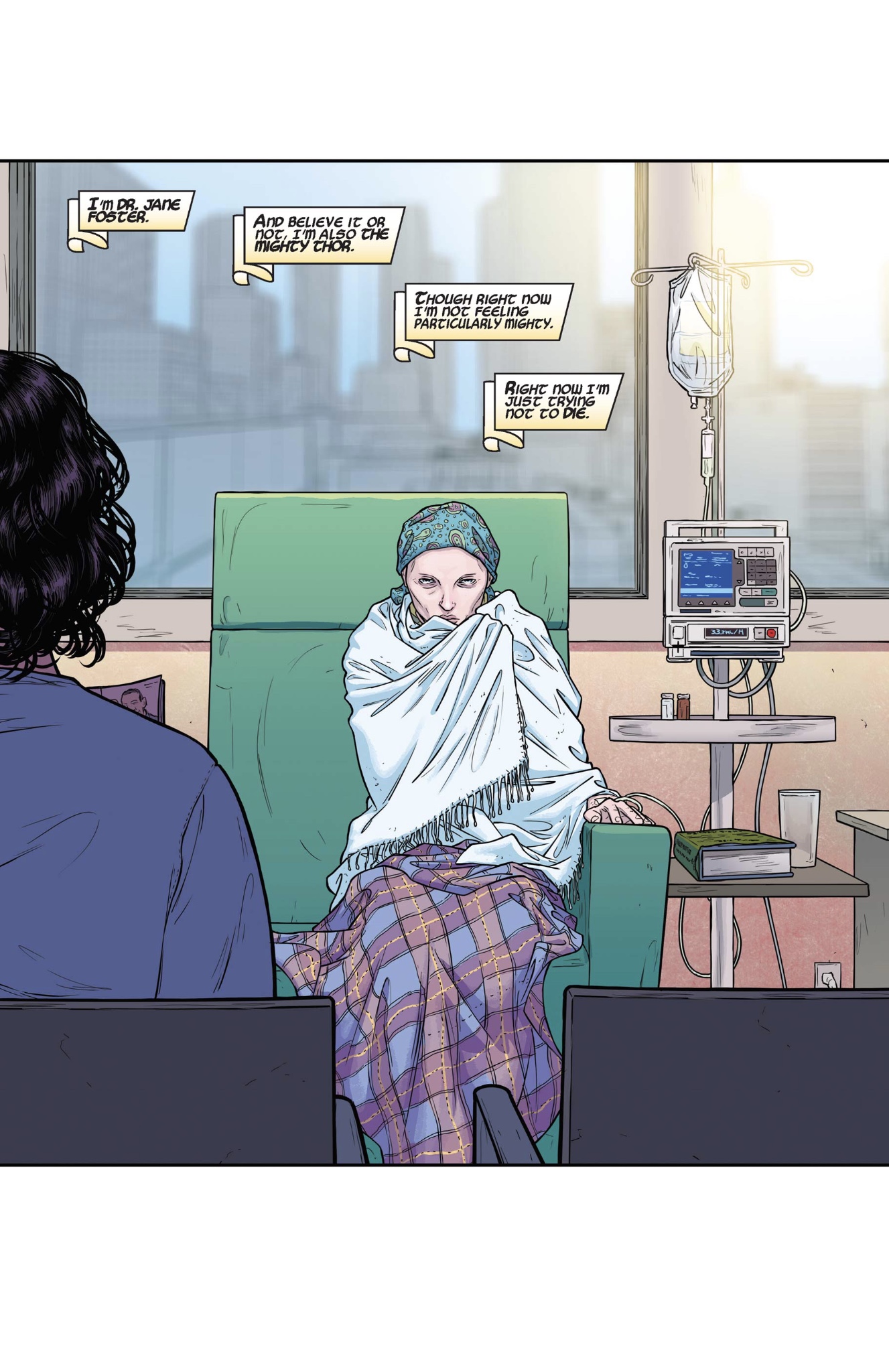
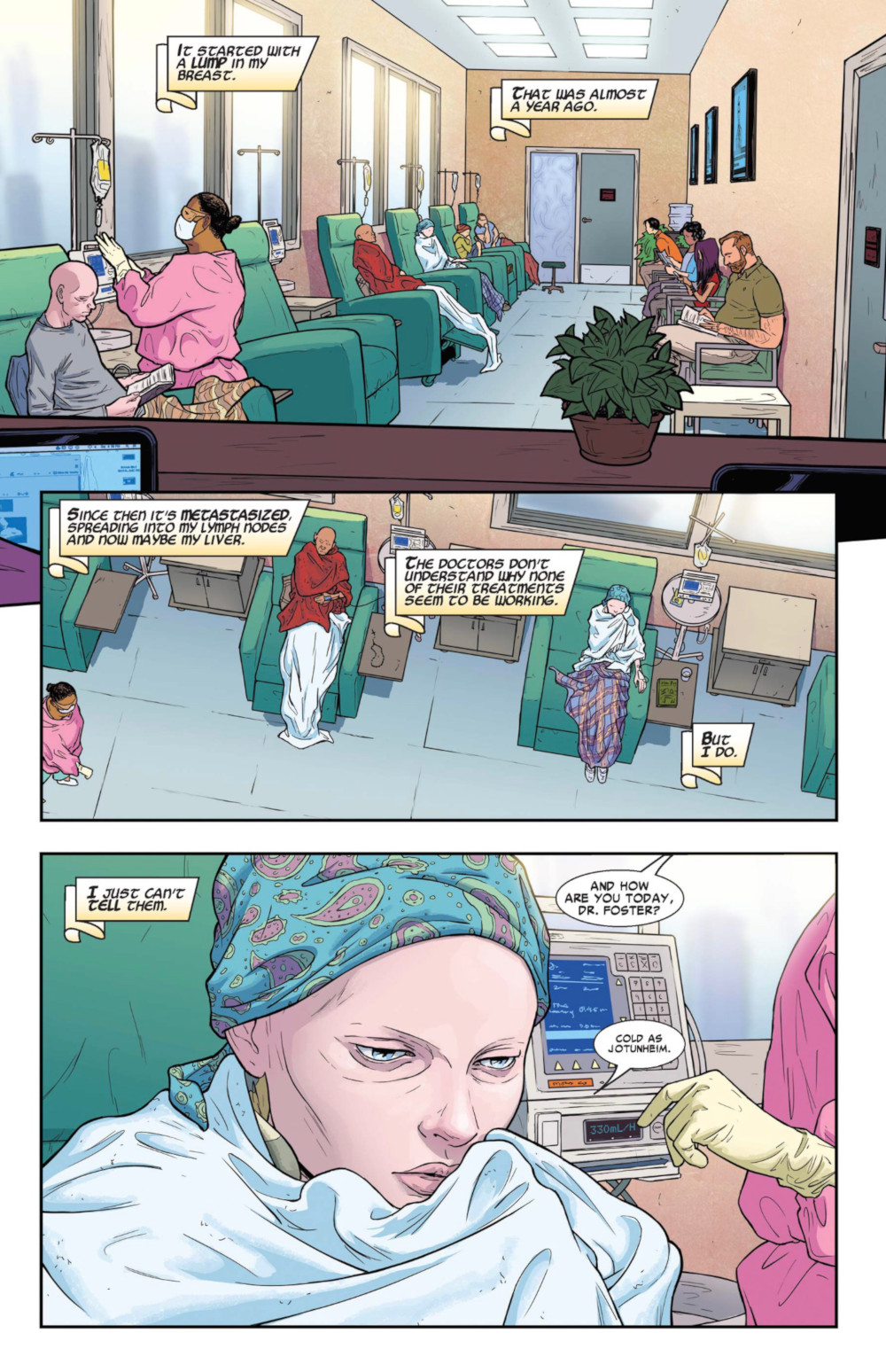
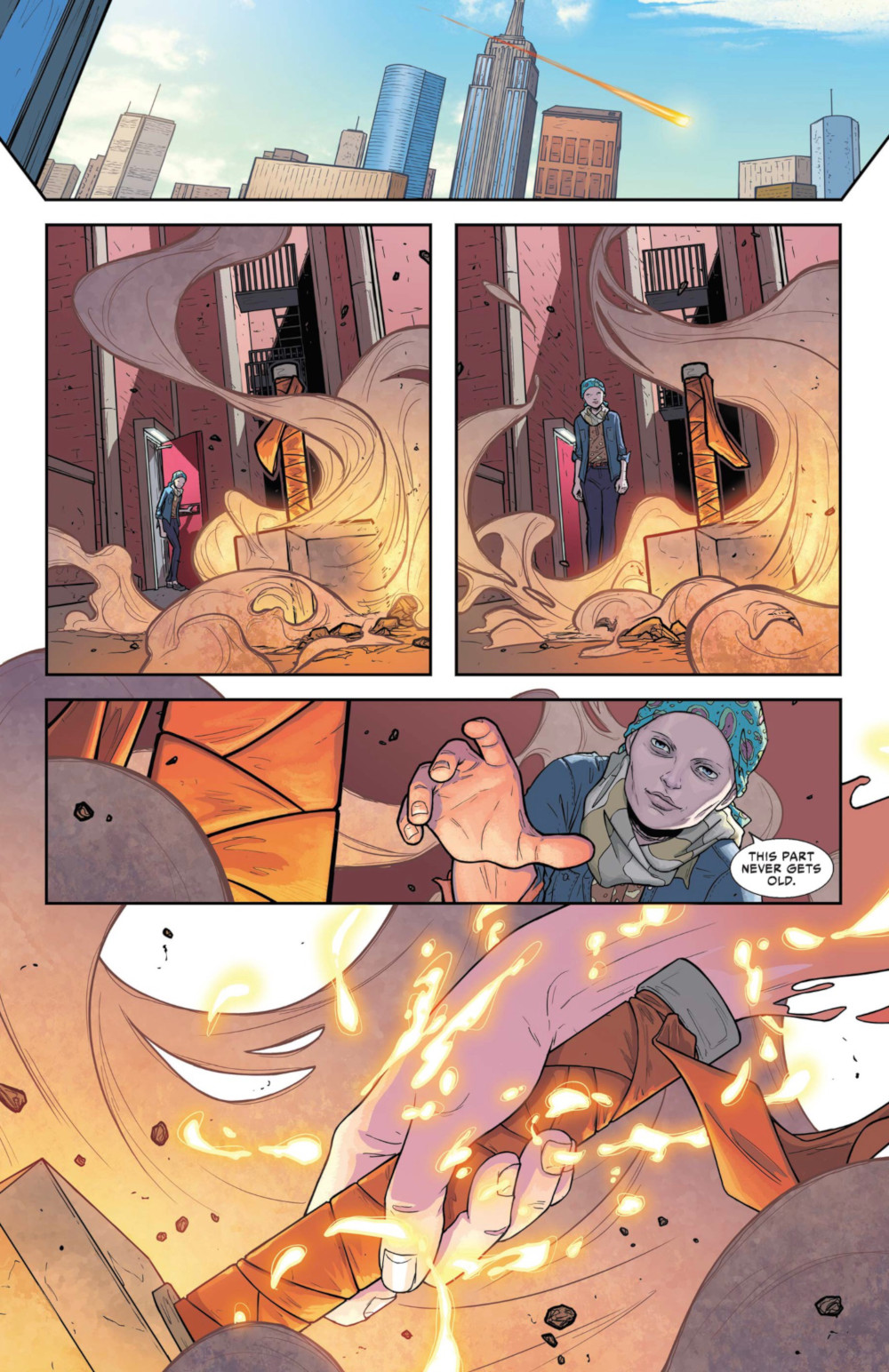
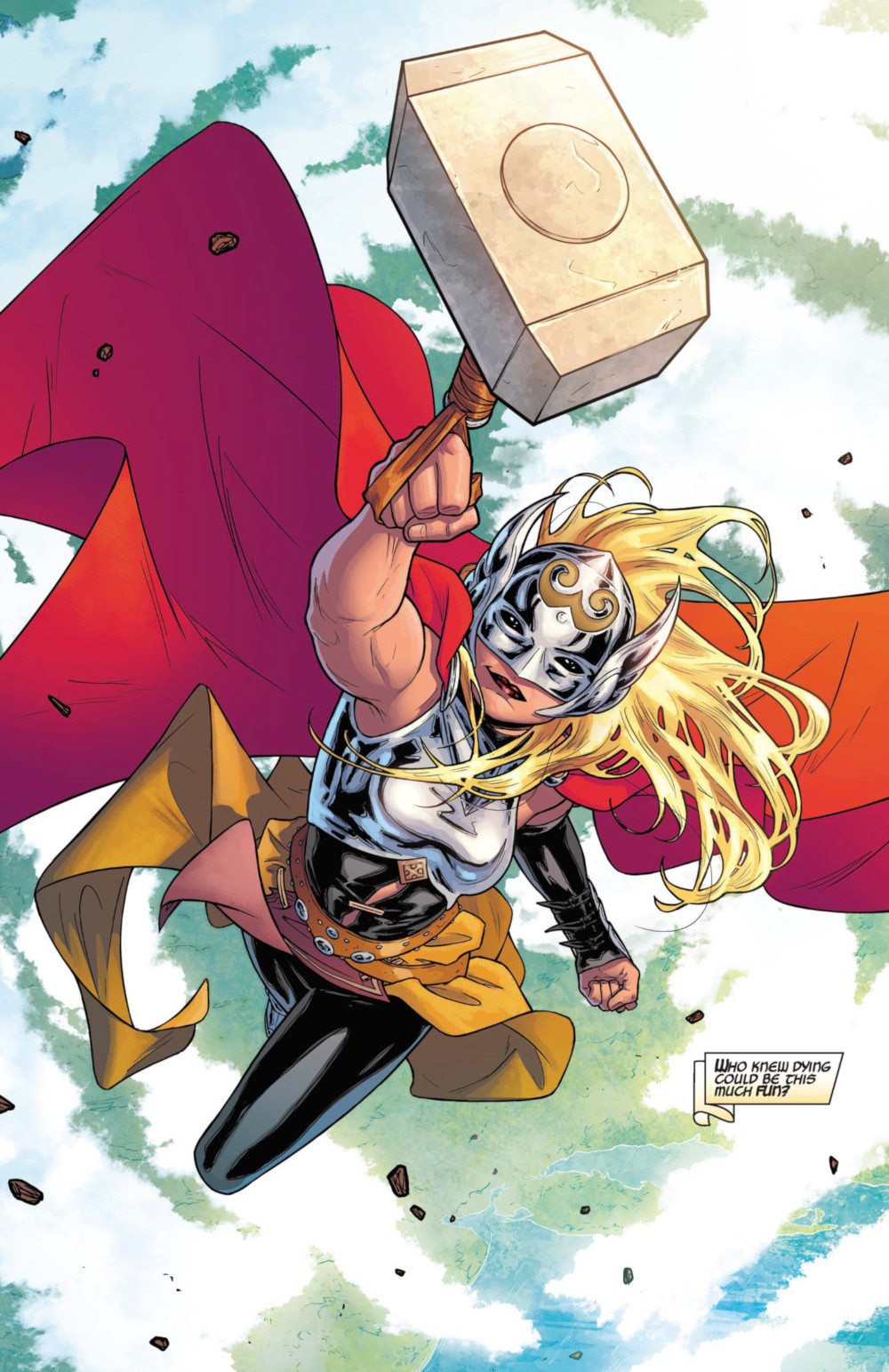
Two phrases were often used to describe Jane’s journey: monkey’s paw and feet of clay. The former is an item that allows someone their greatest wishes, but at a horrific cost. The latter is a core weakness or flaw in a person that makes them beloved. The fascinating thing about Jane as a character is her monkey’s paw – the hammer that turns her into Thor also neutralizes the chemo treatments keeping her alive — is what unlocks that hero with the feet of clay. She knows the cost, but she chooses to help people anyways. It’s an aspirational story of heroism, one of great power and great responsibility. More than that, though, it’s a quintessentially Marvel one.
“She had such a human problem. She was a hero, even though it cost her life,” Moss said. “It doesn’t get more classic Marvel than that.”
“Jane was dealing with very human problems. At the same time, she’s pushing through that to pick up that hammer and fight the good fight while enjoying herself along the way because she knows this might be it,” Aaron said. “’This might be the last time I’m able to pick this up and go flying through space and go punch God in the face.’ She’s loving it. It’s not a morose tale, even though this is the story of a woman who’s slowly dying.
“It’s a tale of this woman loving life and loving what she’s going through despite the struggle.”
Death in superhero comics is a malleable idea, as impermanent as the most minor of inconveniences for the average person. But Jane’s story was different. The team knew how deeply readers had connected with the story, especially those who had dealt with or were currently dealing with cancer in some capacity. Moss said they didn’t want to “disrespect” them by simply magicking away her disease. They knew the character had to die. But they also didn’t want to lose the character. That was a tough line to walk, but one they found an apt solution for.
“Jason came up with a great story to have her actually die and come back in a heroic way that felt true to Marvel and the real world,” Moss said.
That final arc — The Death of The Mighty Thor — was a stunner, with a returning Mangog devastating all in its path, putting a hospitalized Jane in a position where she had to choose between her life as a mortal and protecting the Asgardians she loved, even if the latter would surely kill her. In The Mighty Thor #705, the character saves Odinson, Freyja, Odin, and the remaining Asgardians by using Mjolnir to wrap the unstoppable monster with unbreakable chains before throwing the hammer into the sun, at which point she transforms back into her mortal form because of that separation, bringing on her demise.
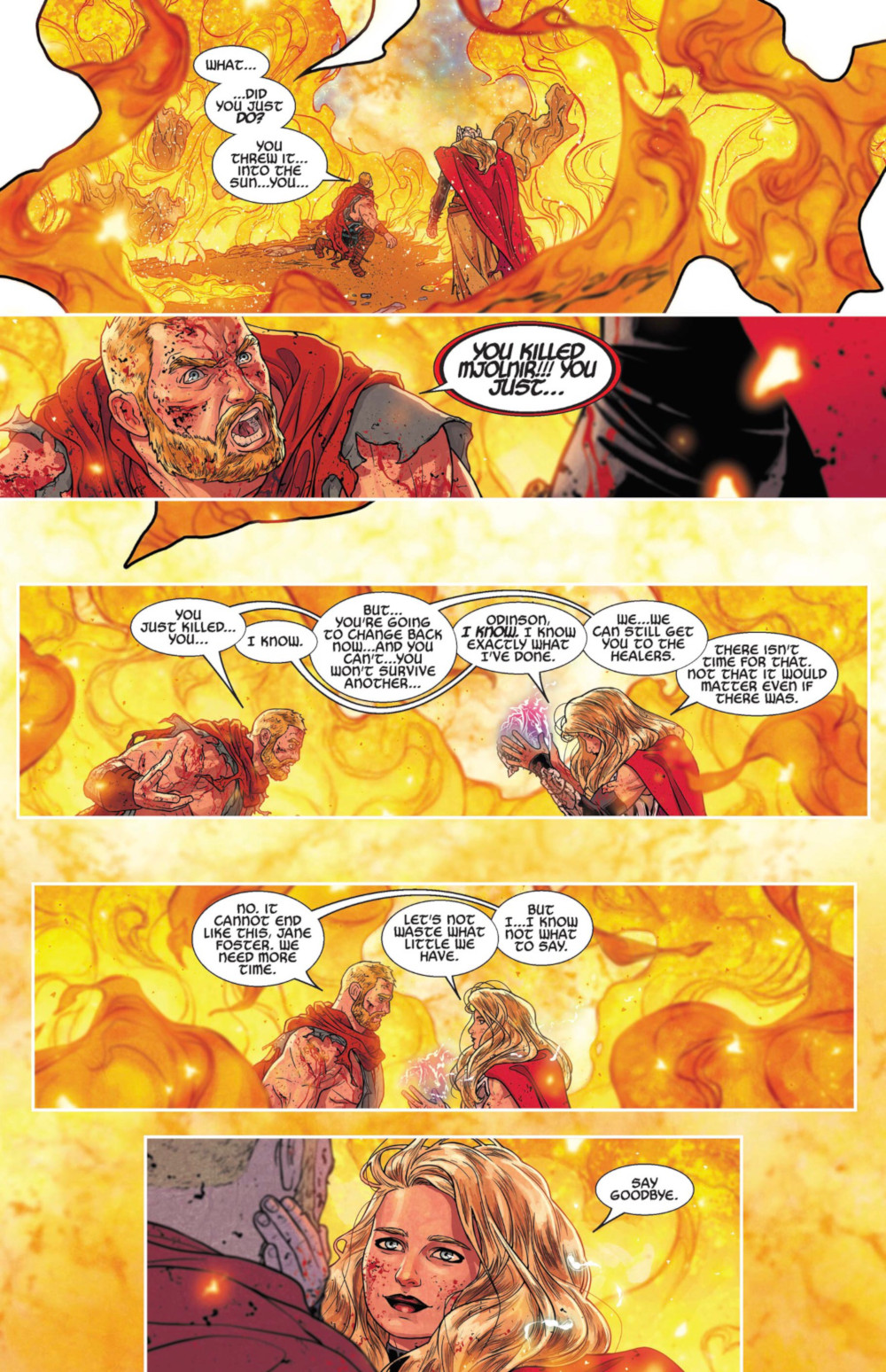
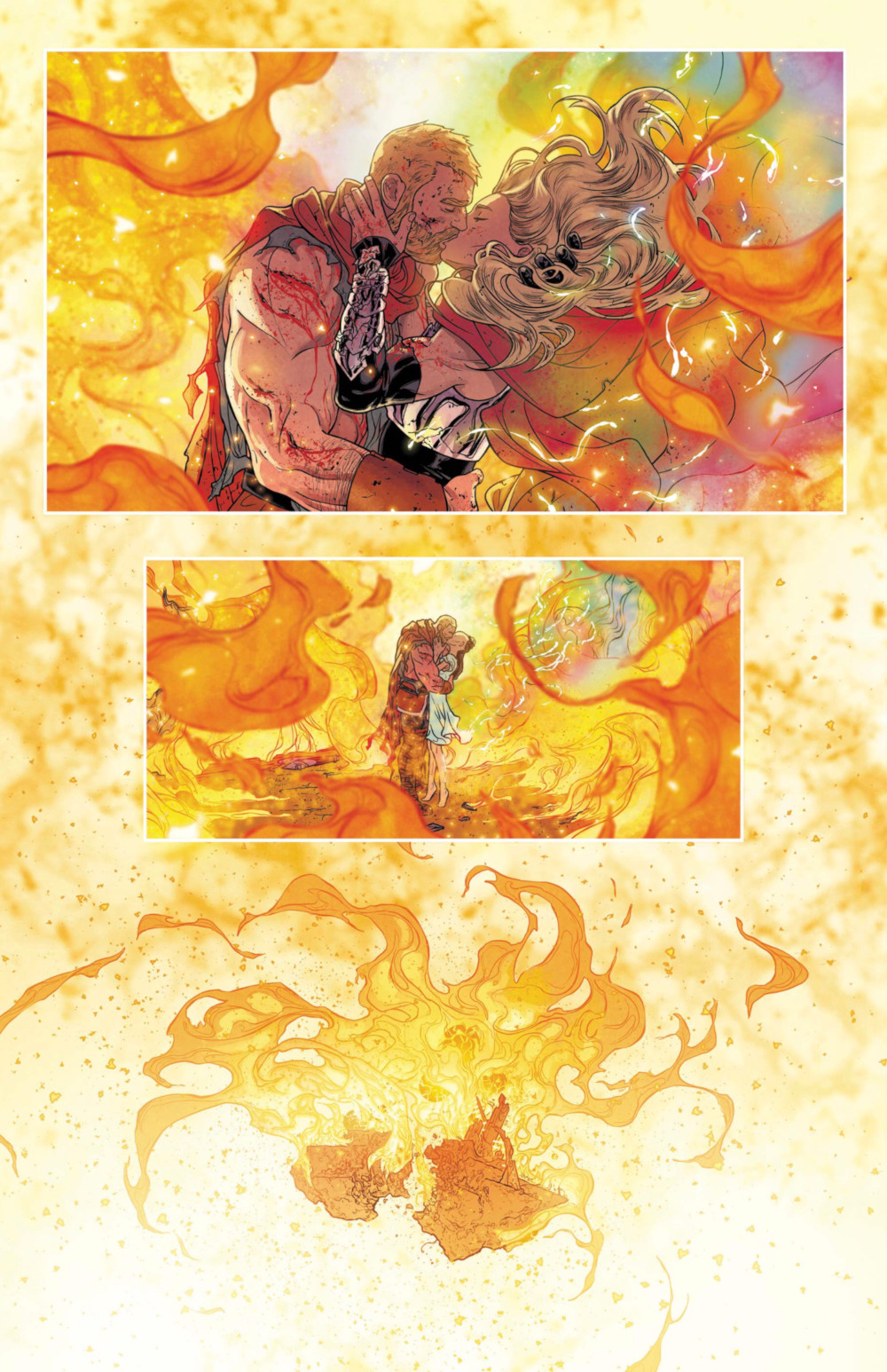
There was just enough time between that throw and transformation for one final, unforgettable moment. Knowing her life was coming to an end, Jane takes off her helmet as Thor for the first time in the series and shares a passionate kiss with Odinson as she returns to her mortal form, dying in the arms of the man she once loved. It’s an incendiary, heartfelt, gut punch of a moment.
And an essential part of it almost didn’t happen.
“(Jane taking her helmet off) wasn’t in the script when I first wrote it. As Russell was starting to turn in art, I realized, ‘Oh shit, we’ve never had her take her helmet off,’” Aaron told me. 14 “I realized we were waiting until this moment. We absolutely need to have her take it off.
“It felt like we’d been planning that for 40 issues when it was a happy accident that happened at the very end.”
The following issue, The Mighty Thor #706, found Jane deceased, welcomed at the gates of Valhalla by her oft-nemesis Odin into a land reserved for the “most venerated of fallen warriors.” It also found Odinson at his most persistent, as he (and eventually Odin) used The Mother Storm — or The God Tempest, an ancient super-storm that resided inside the heart of Mjolnir until Jane’s throw — as the most powerful of all defibrillators to resurrect Foster, giving her one more shot at treatment for her disease and life as a mortal.
The end.
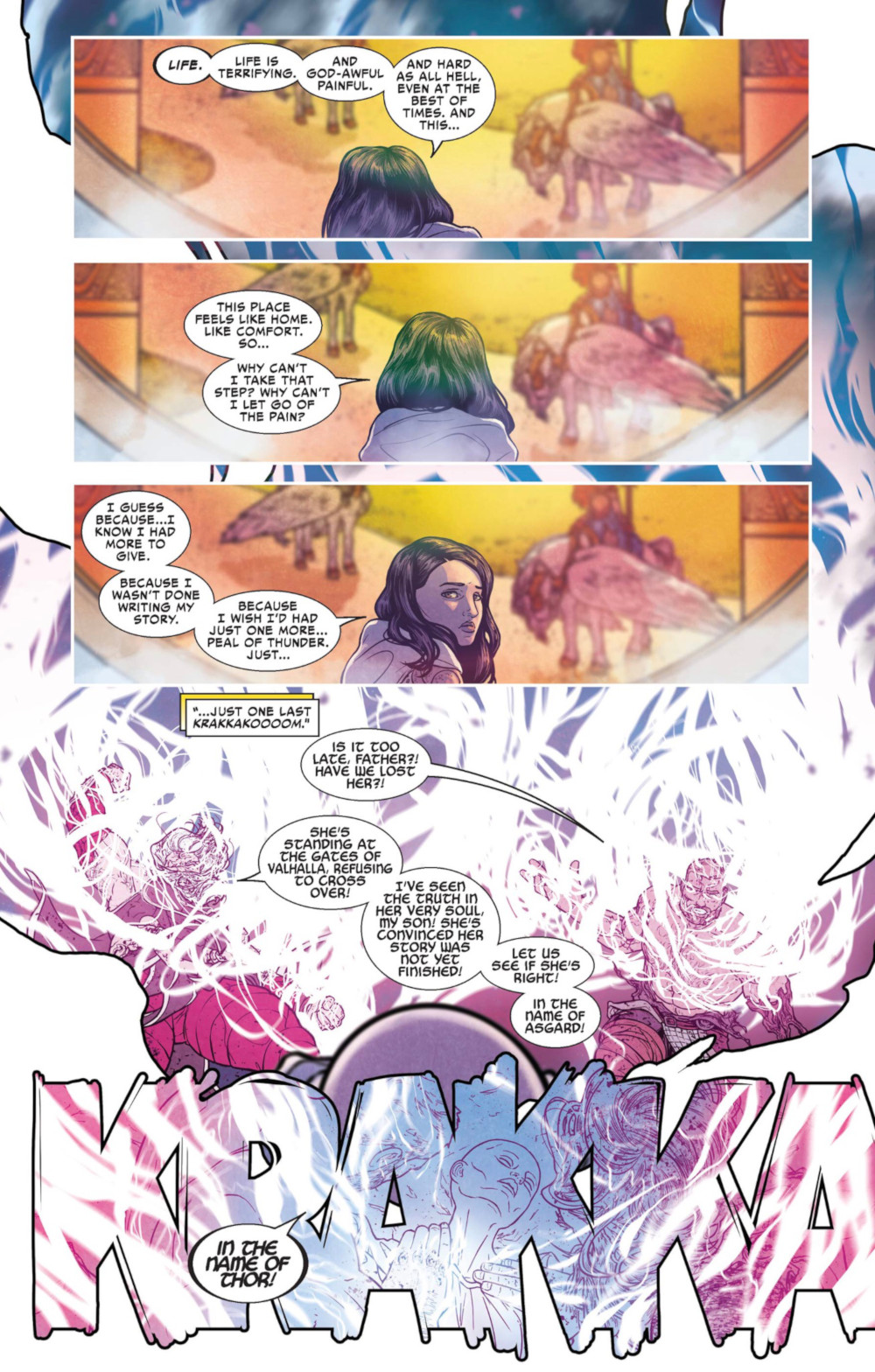
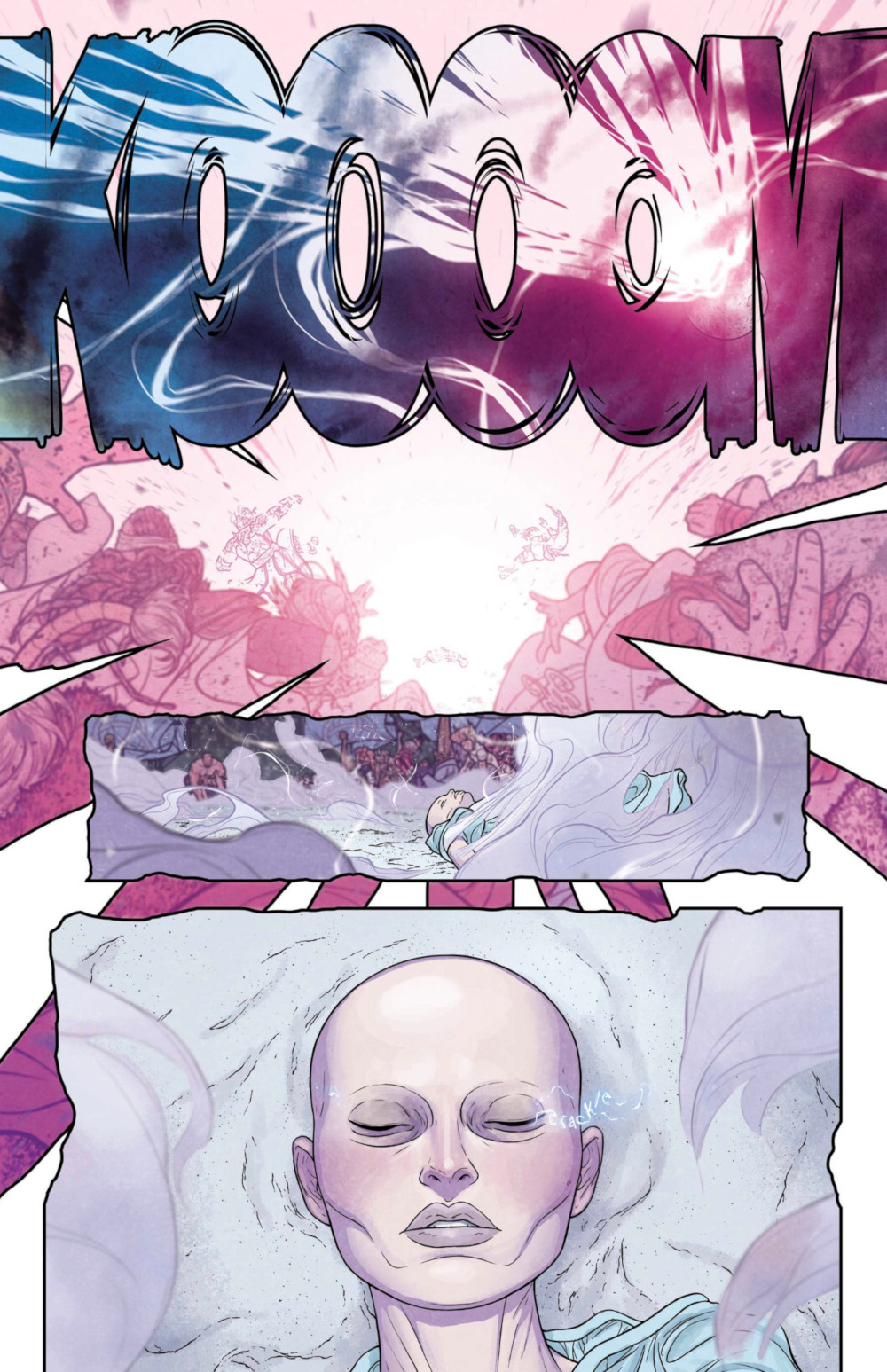
But not really.
Jane returned as Thor in War of the Realms, as Aaron and Dauterman teamed for one final story in this event that acted as the culmination of the writer’s larger Asgard story. It was important to Aaron that that they made permanent one of their most consequential changes to the Thor mythos in the event-concluding War of the Realms #6. That meant one final tweak to the inscription on Mjolnir — “if she be worthy” became “if they be worthy”— and for good.
“Towards the end of (Aaron’s) run, we had a conversation about how he wanted to make sure that ‘they’ would be on there for good, basically,” Moss said. “We were all on board with that.
“But it was just something that I know meant a lot to him.”
Jane’s story as Thor is, of course, not over. It never really is. Especially now. The character will live on forever in Thor: Love and Thunder, as Natalie Portman brings the trials and tribulations of Aaron and Dauterman’s beloved Jane to life on the silver screen. Many are excited for this version of the character, and it’s easy to see why.
And yet, much digital ink has been spilled as of late about Marvel Studios’ complicated relationship with the people who created and defined the characters that appear on the big screen. That uneasiness has grown the more we’ve learned about Thor: Love and Thunder, which feels likely to wear its influences on its sleeve to an even greater degree than its predecessors.
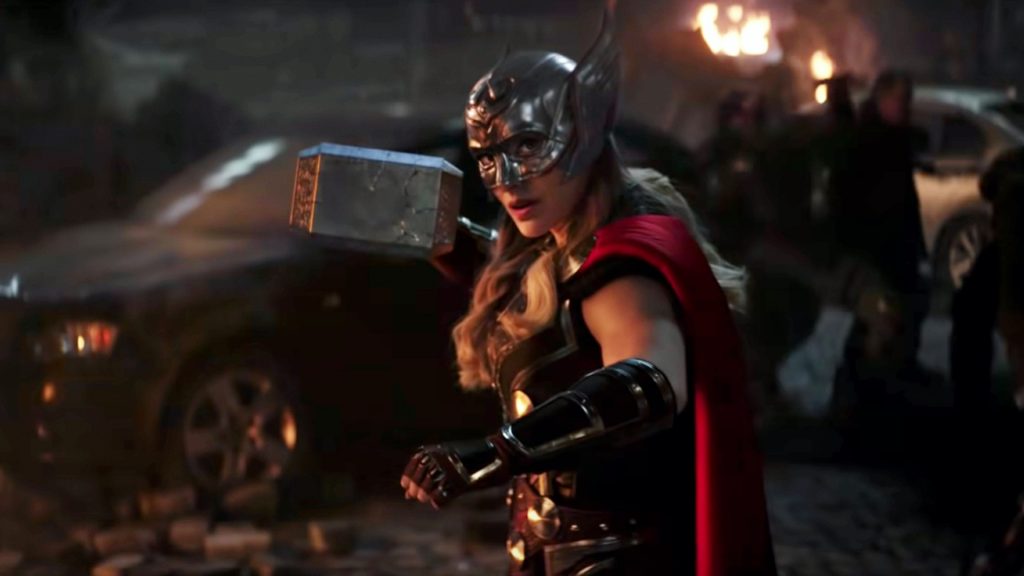
Because of that, I asked Aaron — who was a Creative Consultant on the film — how he felt about his work being shown in such a way. The writer quickly responded with, “It’s all weird,” before emphasizing that everything he does “is still weird” to him…but in a good way.”
“I just sit here, make all this stuff up, and then send it off into the ether. So, it’s weird to go to my comic shop and see books I wrote on the shelf or to see that people want me to sign for them at conventions,” Aaron said. “It’s all still weird in the best possible way. But I’m proud of Jane’s story becoming available to an entirely new audience.”
Pride was a recurring idea here. I’ve talked to a lot of creators about a lot of comics. This team has as much pride in their work as any I’ve spoken to. Not just as storytellers, but as people. Especially now, they recognize the impact it had, even if they were uncertain what the response might be like when they were first getting started.
“I didn’t know if anyone would care about a Thor that wasn’t Thor Odinson, but a lot of people did care about her,” Dauterman shared. “Hearing how much Jane’s story meant to them has really meant a lot to me.”
Aaron was even able to revisit the character right before the movie arrived, as The Saga of Jane played out in the recent Avengers #56. Foster, post-Aaron’s run, is now Valkyrie, operating as a connector between the land of the living and the dead. 15 But in this issue, she’s tempted by a group of Mephistos with the return of Mjolnir to her hand, ending with a sorrowful look when she realizes it wasn’t meant to be. It’s a bittersweet issue, one that finds Jane ruing the life she no longer has.
Talking to Aaron for this piece, it’s easy to believe that this issue was semi-autobiographical, with Jane his proxy and the hammer representing his time with that version of the character. The writer has nothing but fond memories of his work on Thor — as well as a room full of toys to remind him of it — describing it as “one of the best things I’ve ever written.” It’s hard to disagree with his assessment. It’s one of those stories that truly lasts.
That’s the beauty of it, though. Jane’s tale is very much rooted in the stories Marvel “made its bread and butter on 60 years ago,” as Aaron noted.
“Those kinds of stories don’t ever get old.”
While the story of Jane Foster as The Mighty Thor might have been mortal in its own way, always destined to end decisively and with Odinson regaining his hammer, it’s like Foster herself says in her first and last appearances in this run as the Goddess of Thunder: “There must always be a Thor.” And in a way, Jane and her story are as immortal as the gods themselves, living on in the pages of these comics, just waiting for the next person to discover it and fall in love, as we all did then.
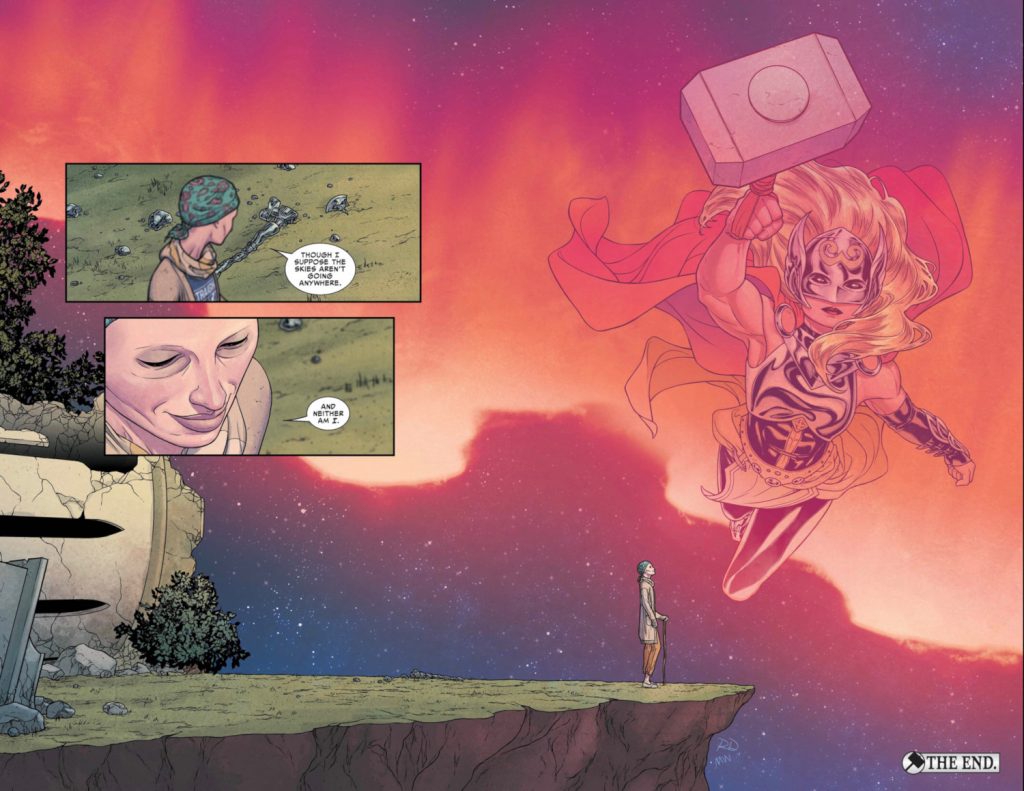
If you enjoyed this feature, consider subscribing to SKTCHD to support the considerable work that goes into making it all happen. It’s just the cost of one comic a month, and you get access to all of the site’s content.
Shouts to Heven, the one you might not know about. It’s a comics only realm that was introduced during Aaron’s run as the place forgotten sister Angela was hanging out at.↩
A quintet of writers that guided the larger line, which included Aaron, Brian Michael Bendis, Ed Brubaker, Matt Fraction, and Jonathan Hickman.↩
And as a Jane story.↩
Which, originally, was, “Whosoever holds this hammer, if he be worthy, shall possess the power of Thor.”↩
In case you were curious and never found out, those were “Gorr was right,” a reference to Thor: God of Thunder’s first villain, a character that believed Gods were worthless and should die at his hand.↩
Supurbia.↩
Thor was replaced by Thors, in this case. Also, if you would like to read more about why the whole line ended, perhaps you’d enjoy my oral history of Secret Wars.↩
I will say, Aaron made a convincing meal out of the misdirection and the reveals that it wasn’t certain people. Having Thor kiss Odinson in Thor #4 to emphasize it wasn’t Freyja was a great beat, in particular.↩
The next volume that launched post-Secret Wars.↩
There’s a moment in The Mighty Thor #5 when Thor is thrown into the storms of Jupiter’s Great Red Spot by Odin and Jane believes she can hear the hammer laughing. She’s…uneasy about that.↩
The hammer actually takes Jane’s human form to throw S.H.I.E.L.D. and assorted others off her scent, even as Jane was grievously injured as Thor.↩
BING!↩
Aaron told me Walt Simonson even reached out to him out of the blue around then. The cartoonist saw his own experiences in Aaron’s, saying “it was the exact same stuff he heard when they did Beta Ray Bill. There was no reason for him to reach out and say that other than just the being a super kind and considerate guy. I’ve always appreciated that.”↩
He did note the character took the helmet off in other titles. But in the main book, Jane’s Thor was committed to her helmet like she was Judge Dredd himself.↩
In a costume designed by Dauterman!↩
